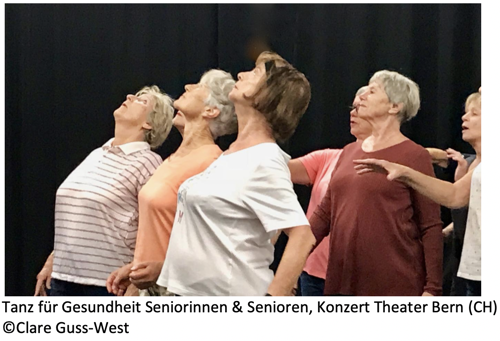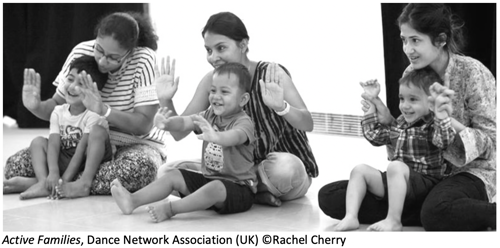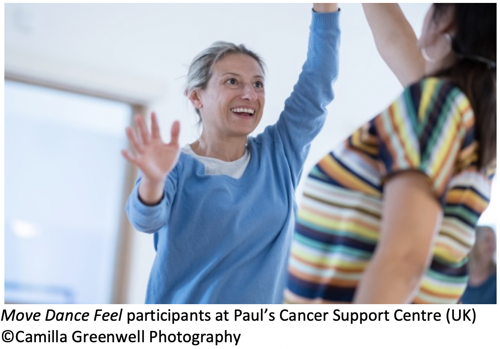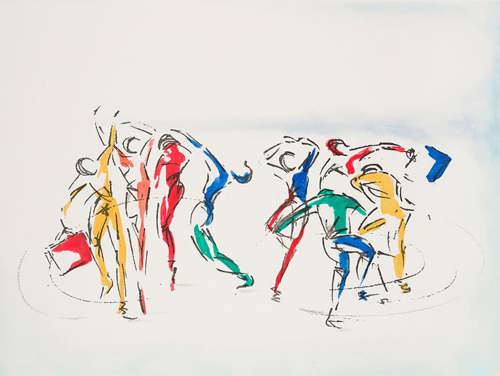Introducing 'Dance for Health'
Authors: Clare Guss-West and Emily Jenkins on behalf of the Dance for Health Task Force
“IADMS enhances health, well-being, training and performance
IN DANCE
by cultivating medical, scientific and educational excellence."
The forthcoming IADMS 2019 conference in Montreal will see an exciting development that reflects the evolution of the IADMS mission statement in the visionary field of Dance for Health (DfH). Capitalizing on IADMS Health for Dance (HfD) expertise, the Association enlarges the focus of its medical, scientific and educational research and activities to validate the role of dance in society and enhance the health of all dancing publics.
Whilst the benefits of dance as a physical activity are widely known1, it is perhaps the components of dance that transcend physical activity which render it an effective, holistic movement form capable of improving our global health. As a physical means of self expression dance enables communication, both internally reinforcing mind and body unity, and externally promoting social cohesion. The creative and communicative elements of dance have attracted the attention of neurologists,2 3 4 physicians and social scientists.
Dance-based, Dance for Health interventions interconnecting with Arts for Health, use evidence-based, high quality, creative arts interventions to promote general health and well-being, stimulating physical, creative and social engagement for all. Arts in Health initiatives are currently impacting change in both national and international public health policies. In the UK, for example, ‘Social Prescribing’ is available from general medical practitioners5, and the National Institute for Health Research calls for research on ‘Participatory Arts to Improve Health and Wellbeing’. Furthermore, the All Party Parliamentary Group on Arts, Health and Wellbeing (APPG) have asked for an accredited module to educate clinicians, public health specialists and other health and care professionals on the evidence-based and practical use of the arts for health and wellbeing outcomes.6 Inspired by the APPG model, The European Dance & Creative Wellness Foundation presented to European Members of Parliament in Brussels last year to highlight the potential innovative role that dance might play in response to some of Europe’s chronic health challenges.
Private healthcare is also actively seeking innovation in the face of global epidemics they identify such as, ‘Sitting’, Depression, Obesity, Type 2 ‘Lifestyle’ Diabetes and to address the healthcare needs of the ever-increasing senior population.7 Some are starting to recognize the opportunities dance offers as Begoña San José, clinical psychologist, Axa France observes,
“We incentivise members for staying physically active. Dance however has multidimensional benefits: It’s music, coordination, fun, social and foremost a positive experience. Gym is also not for everyone. Dancing is!”8
‘Dance for PD’® (Parkinson's Disease) program director David Leventhal, from Mark Morris Dance Group NY, adds:
"In the US, we're starting to see large health management organizations like Kaiser Permanente, which operates in eight US states, approach dance organizations to deliver community-based dance for health programming. Kaiser just sponsored the first year of Dance for Parkinson's classes at San Francisco Ballet, and the program has been a great success."

Participation in dance fosters communication and cohesion both internally and externally. If the intra-systems of the body are not communicating then there is ill health, and similarly if social interaction and cohesion is not supported there is an unhealthy and fragmented society.
“Dance . . . is part of our collective DNA. Our bodies and brains have evolved to dance in synchronized unison and dancing on a regular basis seems to change the way we think and interact with one another.”9 - Christopher Bergland, world-class endurance athlete, coach, author, and public health advocate
An example of how dance can promote interaction and social cohesion is captured in Dance Network Association’s (UK) Active Families project (pictured below). Situated in a deprived area for residents of a culturally diverse neighborhood, the project was designed to prevent isolation by bringing parents and children together to participate in creative dance. As participants spoke a variety of different languages, dance became an alternative means through which to communicate. Outcomes from the project detail that dance has the ability to transcend cultural, social and economic challenges, and bring people together to feel emotionally, physically and mentally connected10.

The potential of dance to enhance internal intra-system communication, as well as promote cohesion and global health, is motivating researchers to explore these exciting new territories. For instance, looking at how dance might build cognitive reserve and stimulate new synaptic connections11 in the case of Dementia, Alzheimer’s and Parkinson’s Disease; enhance neuroendocrine and immune function12; and promote cell regeneration to support the treatment of chronic autoimmune disorders.
Dance-based interventions can support prevention, treatment and management of physical and mental illness. For instance AESOP's (UK) falls prevention dance program for older adults13, and The Alchemy Project (UK) which was designed to support the wellbeing of troubled young adults14. Dance has also been recognized in aiding rehabilitation, recovery and quality-of-life care, such as the work being done at St Elisabeth Hospital, Tilburg (NL), where dancing in the hospital is being explored to support and maintain patient autonomy; and Scottish Ballet’s new dance project ‘Time to Dance’, for people living with dementia and those who care for them, families, and friends15.
Other dance-based interventions may have focused aims, such as reinforcing healthy behavior, or easing side effects of specific pathologies. Examples include a randomized control trial dance intervention for adolescent girls to influence self-rated health (SE)16, and a project supporting women affected by cancer, which uses dance to alleviate negative side effects of diagnosis and treatment such as anxiety and fatigue (UK)17. Such projects have the ability to alter participants’ understanding of, and relationship to, their bodies;
“When you have cancer, you lose touch with your body. It becomes unfamiliar - even worse, it starts to feel as if it is an enemy. For me, dancing started to bring me back to my own body and its energy, strength and basic joyfulness.” 18 - Move Dance Feel participant

The joyful, social, creative and expressive elements of dance are perhaps the precise reasons for its efficacy within health contexts. It is the ‘not therapy’ status of Dance for Health programs, along with the physically communicative aspects, that might account for their success in terms of participant retention and commitment, allowing for long term improvements to health.
This is an exciting time in the development of Dance for Health, as research and international collaborations are solicited and flourishing. IADMS is in a strong position to draw on the breadth and authority of its international membership to lever strategic, institutional change in dance and health policy at a national and international level. IADMS promotes the validation of dance as a life-long partner for health and proactively contributes to deliver the solutions to the pressing needs of all dancing publics, of our society and of our time.
Update March 2021
IADMS Dance for Health definition
Dance for Health provides holistic, evidence-based activities for the individual to manage and adapt to physical, mental and social health challenges.
In Dance for Health sessions, trained teaching artists engage people as dancers, rather than patients, in joyful, interactive, artistic practice.
Dance for Health Vision/Aim:
Promoting dance as a life-long partner for health and well-being.
Dance for Health Mission/Goal:
IADMS promotes innovative research and dance practice, cultivating medical, scientific and artistic excellence in the field of dance for health.
IADMS Global Dance for Health Community
Interested in Dance for Health? Join our online global community on Facebook!

Drawing by Artist Sally McKay
This is a community of supporters and advocates for Dance for Health: of teaching artists, health care professionals, dancers, lecturers, researchers and education and health care strategy makers. Our difference is our strength.
Together we cultivate and magnify Dance for Health advocacy and education, to advance the implementation of this visionary field for the public at large and in targeted health care practice.
This community is a place for sharing ideas, events, education and training opportunities, for networking, collaborating and discussing projects, policies, initiatives, and research. Please feel free to use the group to ask questions and seek opinions from other professionals within the community.
The community is open to all who are committed to the bringing together of the health care and the dance sectors and to the sharing of interdisciplinary knowledge that can serve the development of the Dance for Health field.
Clare Guss-West MA,
Director, The European Dance & Creative Wellness Foundation, IADMS DfH Task Force
(www.danceandcreativewellness.com)
Emily Jenkins MA,
Founder, Move Dance Feel, IADMS DfH Task Force (www.emily-jenkins.com)
Dance for Health Resources
Centres, Programs and Foundations for Dance for Health/Institutes and Lobby Groups
Australia Dance Health Alliance (AUS): www.dancehealthalliance.org.au
National Center for Dance Therapy, Les Grandes Ballets, Montreal, (CA): https://grandsballets.com/en/national-centre-for-dance-therapy/the-centre/
The European Dance & Creative Wellness Foundation: www.danceandcreativewellness.com (NL)
Dance for Health (NL): https://danceforhealth.nl
Switch2Move (NL): http://switch2move.com
Danshälsa, Balettakademien Stockholm (SE): www.folkuniversitetet.se/Skolor/Balettakademien-dansskolor/Balettakademien-Stockholm/PUFFAR/dans-halsa/
Skanes Dans Teater (SE): www.skanesdansteater.se/en/page/more-dance
Dans for Halsa (SE): https://dansforhalsa.se
Dance in Health and Wellbeing (UK): www.danceinhealthandwellbeing.uk
People Dancing (UK): www.communitydance.org.uk
Older adults dancing
Merom, D. & Johnson, N. (AUS) Dancing could help the elderly keep their feet. ABC News, Australian Broadcasting Agency. April 1, 2012. Available at: www.abc.net.au/7.30/content/2012/s3402235.htm#.
‘dancing longevity’, Clare Guss-West, Tanz Senorinnen & Senioren, Konzert Theater Bern (CH): www.sussed-solutions.com
Older people's dance activities - the first UK survey: www.communitydance.org.uk/developing-participation/dance-and-older-people Trinity Laban Conservatoire of Music and Dance – Retired Not Tired, Evaluation Report by Dr Kate Wakeling: www.trinitylaban.ac.uk/sites/default/files/retired_not_tired_evaluation_2012-15_kate_wakeling.pdf
Royal Academy of Dance - Dance for Lifelong wellbeing (UK): www.rad.org.uk/more/dance-for-lifelong-wellbeing/reports
AESOP (UK) - Falls Prevention dance-based Intervention: www.ae-sop.org/dance-to-health/
Balettakademien Stockholm (SE), dancing 60+: www.folkuniversitetet.se/Skolor/Balettakademien-dansskolor/Balettakademien-Stockholm/Kurser/dans-60-plus/
Celebrating the mature dancer who still are on stage http://start.jusdelavie.org/age-on-stage-the-project
Kairos Alive, Maria Genee - Choreography of Care https://kairosalive.org/ (USA)
Dance for Parkinson’s and MS
BrainDance (DE): https://braindanceenglish.wordpress.com/about-us/
IntoDance e.V, Staatsballett Berlin, Soraya Bruno & Annelie Chasemore - (DE): participatory dance class with Parkinson’s and MS dancers. Contact: intodanceberlin@gmail.com www.tamed.eu/wp-content/uploads/2018/04/Bruno-Flick_Workshop2_2-6-2018.pdf
English National Ballet (UK), Dance For Parkinsons: An Investigative (3 year) Study by Houston, S & McGill, A. (2015): www.artshealthresources.org.uk/docs/english-national-ballet-dance-for-parkinsons-an-investigative-study-2-a-report-on-a-three-year-mixed-methods-research-study/
People Dancing (UK): www.communitydance.org.uk/developing-participation/dance-for-parkinsons
‘Dance for PD’ (USA): https://danceforparkinsons.org
Dance and Dementia
Dans Med Meg/Dance With Me, Pauline Hasse (NO): dance for elders and persons with dementia. Contact details: pauline@danceandcreativewellness.com
Dance and Dementia, Pilot Study Research Findings, Smith, N. & Waller, D. (2012) (UK): www.brighton.ac.uk/_pdf/research/ssparc/dance-and-dementia-report.pdf
Going by way of the Body in Dementia Care, Dr. Richard Coaten (UK) (2011): www.communitydance.org.uk/DB/animated-library/going-by-way-of-the-body-in-dementia-care?ed=14076
Green Candle (UK): www.greencandledance.com/participation/older/dance-and-dementia/
Dance and Mental Health
Duberg, A. et al. Influencing Self-Rated Health Among Adolescent Girls with Dance Intervention, A Randomized Control Trial (SE) (January 2013): jamanetwork.com/journals/jamapediatrics/fullarticle/1390784
Restoke (UK) Man Up performance about masculinity and mental health: www.restoke.org.uk/man-up
Dance United (UK) The Alchemy Project: www.artshealthandwellbeing.org.uk/case-studies/alchemy-project
Professor Peter Lovatt, Reader and Principal Lecturer in Psychology, University of Hertfordshire (UK), What is Dance Psychology? What types of questions are you trying to answer? (March 2017): www.news-medical.net/news/20170308/Can-dancing-improve-your-mental-health.aspx
Dance and Cancer
Theatre Freiburg - Die Krone an meiner Wand (DE): https://theater.freiburg.de/de_DE/spielplan/die-krone-an-meiner-wand.14903135
Move Dance Feel - Dance for Women Affected by Cancer (UK): www.emily-jenkins.com/movedancefeel www.facebook.com/movedancefeel
Dance with Visually Impaired
Royal Opera House (UK): www.roh.org.uk/news/ballet-for-the-blind-and-visually-impaired
Rationale - Breakdance and Visual Impairment (UK): www.communitydance.org.uk/DB/animated-library/breakdance-and-visual-impairment www.vice.com/en_us/article/53wv7a/visual-impairment-breakdancing-provides-possibility-sight
Dance and Psychology/Neuroscience
Bergland, C. The Powerful Psychological Benefits of Dance (2018): www.psychologytoday.com/intl/blog/the-athletes-way/201805/the-neuroscience-dance
Brown, S. & Parsons, LM. The neuroscience of dance. Sci Am. 2008; 299(3):78-83. (2008)
Poikonen, H. Movement and Neuroscience: http://wisemotionco.com www.psychologytoday.com/us/blog/the-guest-room/201111/is-dance-the-next-wave-in-cognitive-neuroscience https://www.helsinki.fi/en/news/health/a-dancers-brain-develops-in-a-unique-way
References
- Fong Yan A, Cobley S, Chan C, Pappas E, Nicholson LL, Ward RE, Murdoch RE, Gu Y, Trevor BL, Vassallo AJ, Wewege MA, Hiller CE. The effectiveness of dance intervention on physical health outcomes compared to other forms of physical activity: a systematic review and meta-analysis. Sports Medicine 48(4):933-951
- Poikonen H. Dance on Cortex - ERPs and Phase Synchrony in Dancers and Musicians During a Contemporary Dance Piece, University of Helsinki, 2018. Available online.
- Lossing A, Moore M, & Zuhl M. Dance as a treatment for neurological disorders, 2016. Available here. Pages 170-184
- Brown S, & Parsons LM. The neuroscience of dance. Sci Am. 2008; 299(3):78-83. Available online.
- Robinson A. Social prescribing: coffee mornings, singing groups, and dance lessons on the NHS, BMJ 2018;363:k4857. Available here.
- All Parliamentary Group on Arts, Health and Wellbeing Annual Report 2017-18: Available here.
- Woei-Ni Hwang P, & Braun K. The Effectiveness of Dance Interventions to Improve Older Adults’ Health: A Systematic Literature Review 2015. Available here.
- San José B. Moving Towards Mental Wellbeing, Presentation, The European Parliament, Brussels 2018.
- Bergland, C. The Neuroscience of Dance, Psychology Today, 2018. Available here.
- Urmston E. Active Families Evaluation Report 2017. Available here.
- Powers R. Use it or lose it: Dancing makes you smarter. Stanford Dance, 2010. Available here.
- Liponis, M. Ultra-longevity. New York: Little, Brown & Company, 2007.
- Aesop. Dance to Health - An Evaluation, 2017. Available here.
- The Alchemy Project, Dance United in partnership with the Institute of Psychiatry at Kings College, 2016. Available here.
- Time to Dance, Project Scottish Ballet 2019. Available here.
- Duberg A. et al. Influencing Self-Rated Health Among Adolescent Girls with Dance Intervention, A Randomized Control Trial, 2013. Available here.
- Jenkins, E. Move Dance Feel: Exploring Dance and Wellbeing with Women Recovering from Cancer, 2016. Project Trinity Laban Conservatoire of Music and Dance.